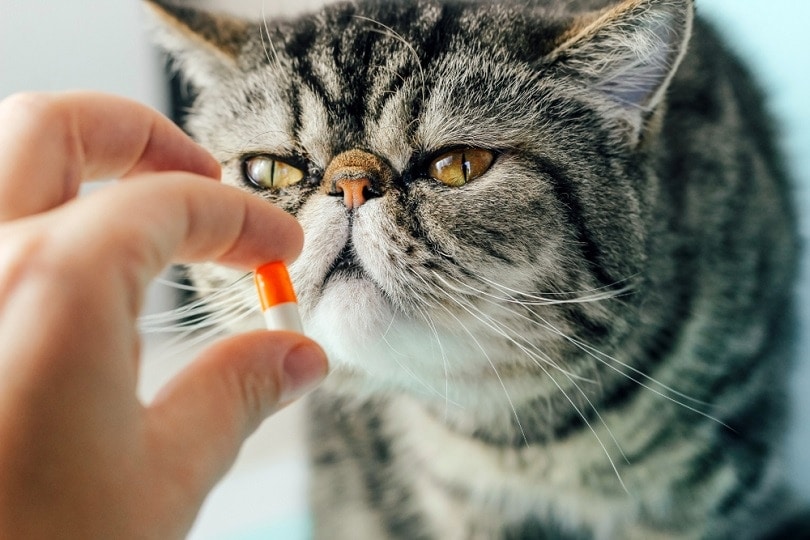How To Transfer Betta Fish Into a Tank: Our Vet Answers
By Dr. Luqman Javed, DVM (Vet)
Updated on
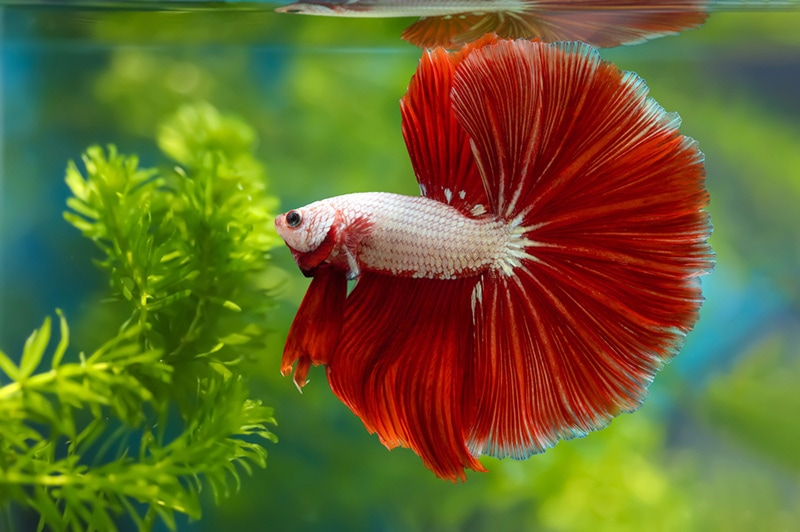
Click to Skip Ahead
Adopting a new pet fish is an exciting prospect for most aquaculture enthusiasts. With a wide array of fin types, colors, and sizes, picking a betta to bring home can be equally thrilling and riveting! To have your mind settled on your betta is also often associated with a sense of joy.
However, the process of actually introducing your betta to their new home is a task in itself that requires care and patience. In this article, we’ll review the ins and outs of introducing your beloved pet betta from their shipping bag into an aquarium.
Before Bringing Your Betta Home
Before you bring your betta home, you should go over a checklist to ensure you’re ready to adopt them.
Research Your Source
Thoroughly research the source where you will adopt your betta from. If you plan on adopting a betta from a pet store, pay close attention to how the bettas are housed. It’s also advised to pay very close attention to the other fish in the store. If they seem unthrifty, unwell, or injured, extreme caution is advised, as your prospective betta might be carrying some unwanted diseases. This risk is much higher if you notice that the betta’s holding tank shares a centralized filtration system with the tanks in the store.
A reputable breeder is preferred by most enthusiasts because they often carry interesting varieties of bettas and usually take pride in their fish’s health. Breeders that are well renowned may also provide you with useful tips for the care of a betta and might also have a good stock of live feed you can purchase along with your betta.
The downside here is that bettas purchased from a breeder usually cost more; however, the benefits of adopting from a reputable breeder usually easily outweigh the price tag on their fish. It’s also important to note that supporting breeders may help curb the mass breeding of bettas that end up in stores (as many of these fish are unfortunately housed in very poor conditions).

Get to Know Your Betta
In addition to understanding your source, you should also get to know your betta a little before you adopt them. You should take the time to discuss your betta on an individual level. Questions you should ask include the following:
- Age. Bettas are best if adopted when they are around 4-5 months old, though many can be rehabilitated when they are around 2 months old. However, a betta that is 2 months old is a juvenile and will likely require closer attention to their nutritional needs.
- Current diet. This would make the transition into your home much easier. You would know their likes and dislikes and plan accordingly.
- Aggression levels. An individual that spends most of their time flaring might not be the best choice in a community setup.
- Breeding history. If you plan on breeding bettas, you should look for an individual that has had breeding success. A young male with an architectural flair for making large, well-placed bubble nests who isn’t overly aggressive towards a female is desired. When adopting bettas to breed, ensure you ask when they were last bred as well, as they should be rested for a period of at least four weeks in between spawning cycles to ensure their health and well-being.
Getting this information from pet store employees can be tricky and often not successful. Many bettas sold in pet stores are retired breeders that are around a year in age (or older), or those that are deemed unfit to be bred. Their age can be estimated by the length of their pelvic fins. Older individuals have longer pelvic fins. However, some diseases (such as fin rot) can result in their fins looking shorter than they actually should be. Most bettas sold in stores are past their breeding prime age (but maybe bred successfully at times).
Have a Suitable Tank
Ensure you have a cycled aquarium ready for your betta. A single male betta requires a 5-gallon tank as a minimum. The tank should be filtered and heated and should contain safe ornaments for your betta. Bettas are also often appreciative of live plants and resting perches (such as hammocks). Because bettas can easily jump, your tank should have a lid as well. You should also have a net, a water testing kit, and a water conditioner.
Important: If your betta is going to be joining a community tank, you should place them in a quarantine tank for a period of at least four weeks (six weeks is ideal) before introducing them to the community aquarium. This quarantine tank should have the same requirements as described earlier. Always research all species you plan to house with your betta thoroughly.
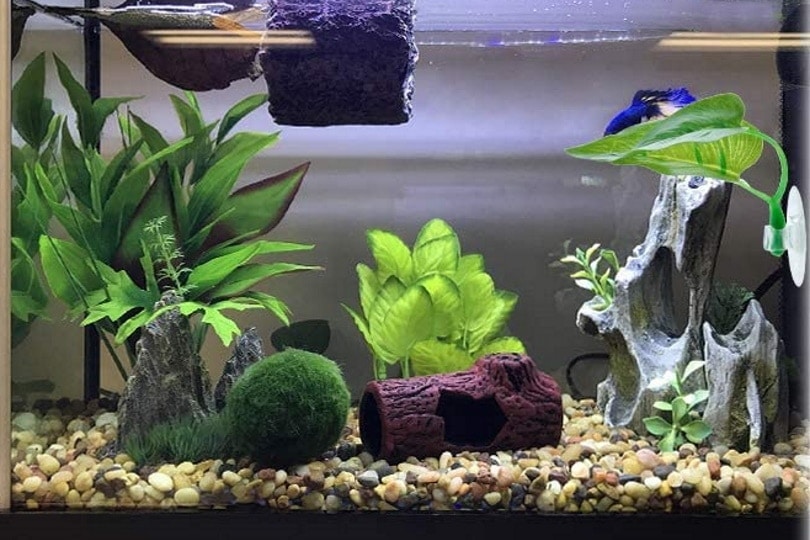
Other Optional Supplies
The following supplies are optional but great to have around before adopting a betta:
- A hospital tank
- Fish first aid kit (with some stress medication, aquarium salt, etc.)
- A thermometer (to assess the temperature of the room your betta will be placed in)
- Spare filter cartridges
- Spare aquariums or buckets (if you plan on growing live feed yourself)
Pet Fish Transport
Your betta will likely be placed in a plastic bag filled with oxygen, and the bag will usually either be tied or sealed for their safety. At times, you might also notice the water in the bag your betta is shipped in is of a different color. This happens when shippers add medicine to the water to neutralize fish waste and ammonia, providing an added layer of safety for a long ride. There are some precautions you should take depending on how your betta is being transported.
Transporting the Fish Yourself
If you are transporting the fish yourself, ensure that picking up your betta is last on your “to-do” list while you’re out. Essentially, your goal should be to have your betta spend the least amount of time possible in their transport bag as possible.
It’s a good idea that your betta be “double bagged” as an added precaution. Be mindful of other items you may be carrying in your hand; a sharp object can puncture the bag your betta is held in, which you would definitely want to avoid.
While transporting your fish (either by walking or while in any mode of transport), try your best to avoid any bumps, sudden movements, or abrupt stops (such as slamming on your brakes). You should not run while holding your fish. It’s best to wrap your fish in a secure blanket or a towel. This should be considered mandatory if the weather outside is cold and the ambient temperature is below 25°C (77°F).

Receiving a Betta
If your betta is being shipped to you, ensure you liaise with your breeder or delivery company to ensure that they do not incur any delays. For example, if the delivery service does not operate on a weekend, you should not place your order on the last working day of the week. Likewise, if a public holiday is expected to cause shipping delays, you should consider another day to have your betta sent to you.
Many breeders that offer a delivery service for their fish have a refund policy if the fish does not survive the trip. Therefore, before unboxing your fish, it’s a very good idea to film the entire process for proof for a refund claim. Pay close attention to any markings on the packaging to determine which side is up. Be careful while opening the box, as sharp objects may puncture the bag inside if you rush the process of unpacking the container.
IMPORTANT: If your betta is shipping in a box, you should NOT unbox them in a bright room. A sudden transition from darkness to extreme brightness can shock fish to death. You should slowly unbox your betta in a dimly lit room to allow them some time to adjust to the brightness of their surroundings.
The 7 Steps of Acclimation Process
Once you’re ready to add your betta to their tank, you may do so by what is known as the acclimation process. Essentially, the goal of this process is to allow your betta time to slowly adjust to the water in their new environment. This process is very important and should not be taken lightly or rushed. A rapid change in water parameters can be very stressful for fish. Here’s a step-by-step guide for this process:
1. Float the Bag
Begin by floating your betta’s bag in their new home while it is still sealed for at least 20 minutes. Ensure that the current in the water isn’t too strong to thrash the bag around. It is also a good idea to turn the aquarium’s light off for this process, as a bright light very close to the bag may cause the water inside the bag to heat up quickly, which can be stressful for your fish.
It is normal to notice your betta bump their head into the plastic bag to try and explore their new surroundings. Rest assured that doing so doesn’t hurt your betta. Keep a close eye on your betta to gauge for any signs of stress. These include a sudden change in your betta’s color, a lack of curiosity, or your betta appearing to breathe heavily. If they do so, remove the bag from the aquarium and see how they behave after about 5 minutes. Check the aquarium’s water using your test kit to ensure it is appropriate for your betta.
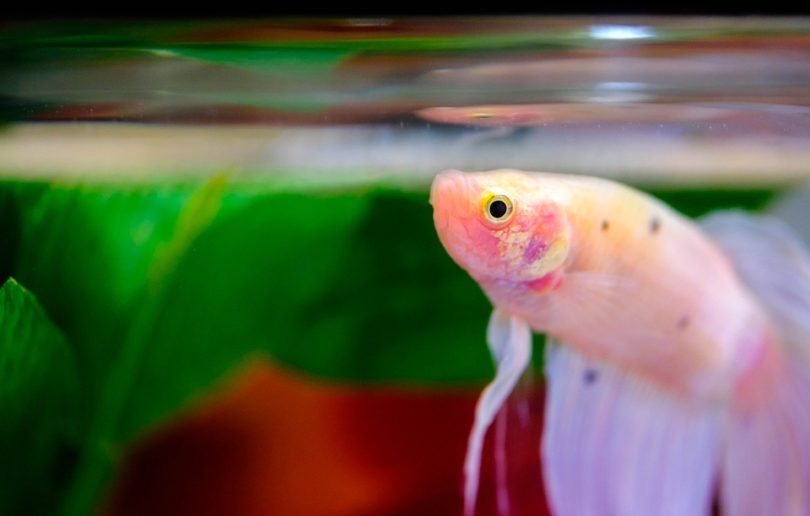
2. Add Aquarium Water
After 20 minutes have elapsed, gently open your betta’s bag and add a little bit of aquarium water into the bag. While doing so, do not allow the water from your betta’s bag to spill into the tank. The amount of water you add from the aquarium should be only about 10% of what’s in your betta’s bag.
Re-tie the bag and allow your betta to float again for a period of about 5–10 more minutes. When you initially untie the bag, the oxygen in the bag (if it was added before the trip) will naturally escape. However, this isn’t a concern for your fish. As a labyrinth fish, bettas can breathe atmospheric oxygen. Continue to monitor your betta as they float.
3. Add More Water
After 10 minutes of floating with some aquarium water in their bag, repeat the process by adding even more aquarium water into the bag. The amount of water you’ve added from the aquarium into the bag should now be around 20–25% of the water in your betta’s bag. Float your betta for another 5–10 minutes.
4. Repetition
Every 5–10 minutes, repeat Step 3 by carefully adding more aquarium water into the bag and monitoring your betta’s response as you continue to float them.
Do this until you are confident that over half the bag in your betta’s bag is from the aquarium, and they seem to be adjusting to the water without any signs of stress.
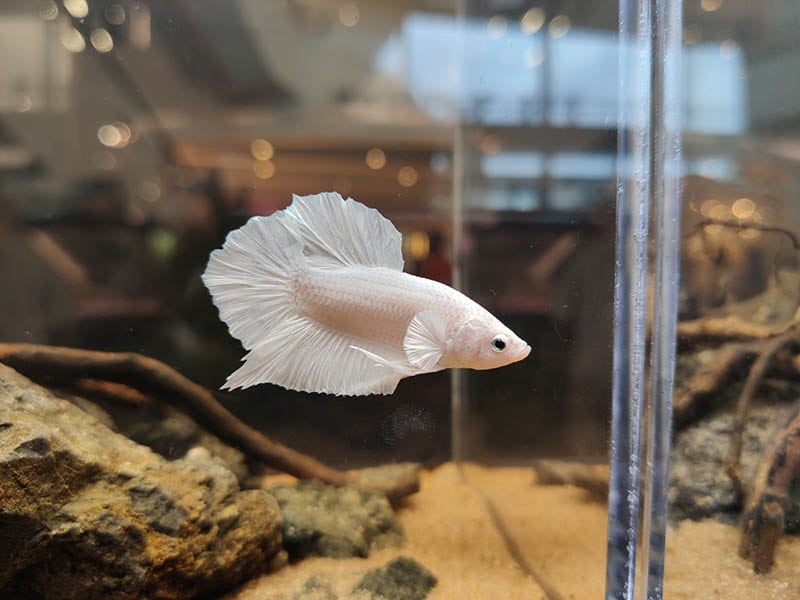
5. Scoop Out
After about 45–60 minutes (longer in some cases), your betta should be ready to transition to their tank. To do so, carefully open their bag, and use the net to gently scoop out your betta. A delicate cloth-based fish net is recommended for bettas; this ensures you don’t inadvertently injure or tear their fins as you scoop them out.
With your betta secure in your net, gently lower the net into the aquarium to let your betta swim free into their new home. It is very important to not invert the net to “toss” your betta into the tank but rather be gentle with the process. Once submerged, the net can slowly be maneuvered to release your betta into their home.
It is also very important to NOT introduce water from the bag into the aquarium. This is done in case something in the water is harmful to your aquarium; you do not want these harmful agents in your aquarium. Transport water may also contain fish poop and other waste (such as ammonia), which is why you should discard it and not add it to your aquarium.
6. Observe Your Betta
With your betta in your new aquarium, ensure you place the lid back onto the aquarium. Allow your betta some privacy to explore their new home. It is advised not to feed them for the first day; they are usually too curious to explore their new surroundings and often don’t show interest in food for a day or so. Uneaten food may spoil and cause an unwanted ammonia spike in your aquarium.
Note: Juvenile bettas (under 5 months old) should be fed on a daily basis. It’s best to ask their breeder to feed them before you bring them home. Bettas older than 5 months of age have no issues with fasting for a day as they explore their home.
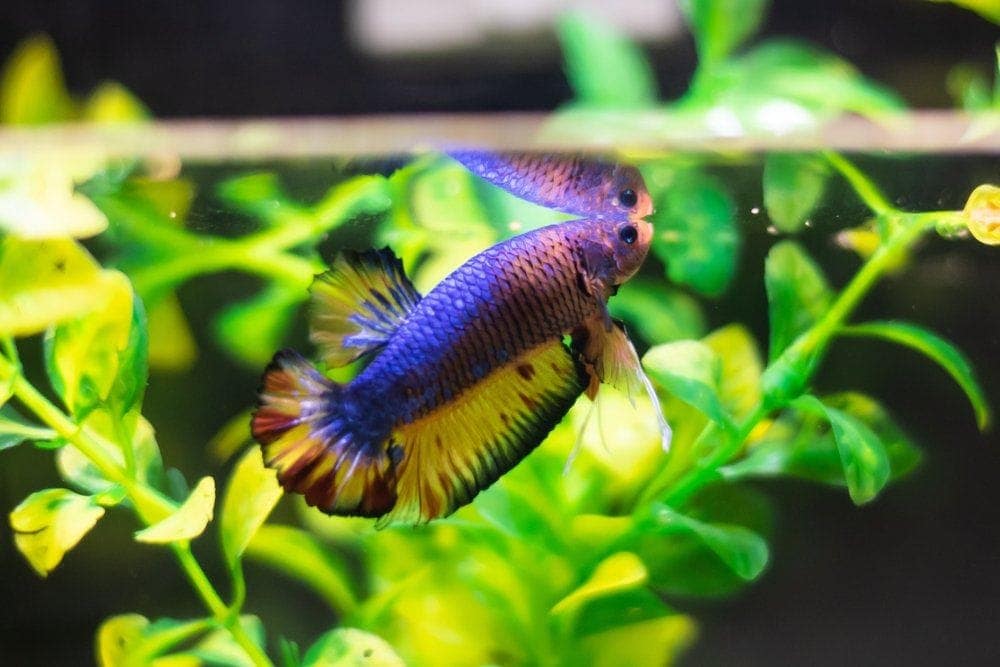
7. Congratulate Yourself
With the completion of the acclimation process, you should feel proud of safely introducing your betta to their new home! Though it is slow and arduous, it’s definitely very important and rewarding. After about a day or so of exploring, your betta should be keen to eat and will quickly anticipate your approach to their tank, as they can quickly learn to associate you with food.
Frequently Asked Questions
Can I Speed Up the Process?
As a rule of thumb, the risk of rushing the acclimation process is not a worthwhile experiment. The acclimation process may seem very long, especially the first time you do it. Many first-time pet owners are curious about shortcuts to speed up the process. With a few extra steps, you may be able to speed the process up slightly.
The extra steps are water parameter checks that compare your aquarium water to the water inside your betta’s bag.
- pH
- Temperature (very important)
- Water hardness (dH)
- Salinity
The more similar these values are from both sources, the shorter the acclimation period would be for your betta (as they would be used to “such waters”). Many of these parameters require individual purchases of an appropriate testing kit.
Caution: All these tests should not be done in water that contains live fish; collect some water and test it without any life form inside. Be especially careful when testing for salinity, as the salinity meter runs an electrical current through the water.
If the parameters are exceptionally close, you would likely only need to acclimate your fish for a period of about 25–30 minutes. However, if one or more of them are different, you should not rush the acclimation process.
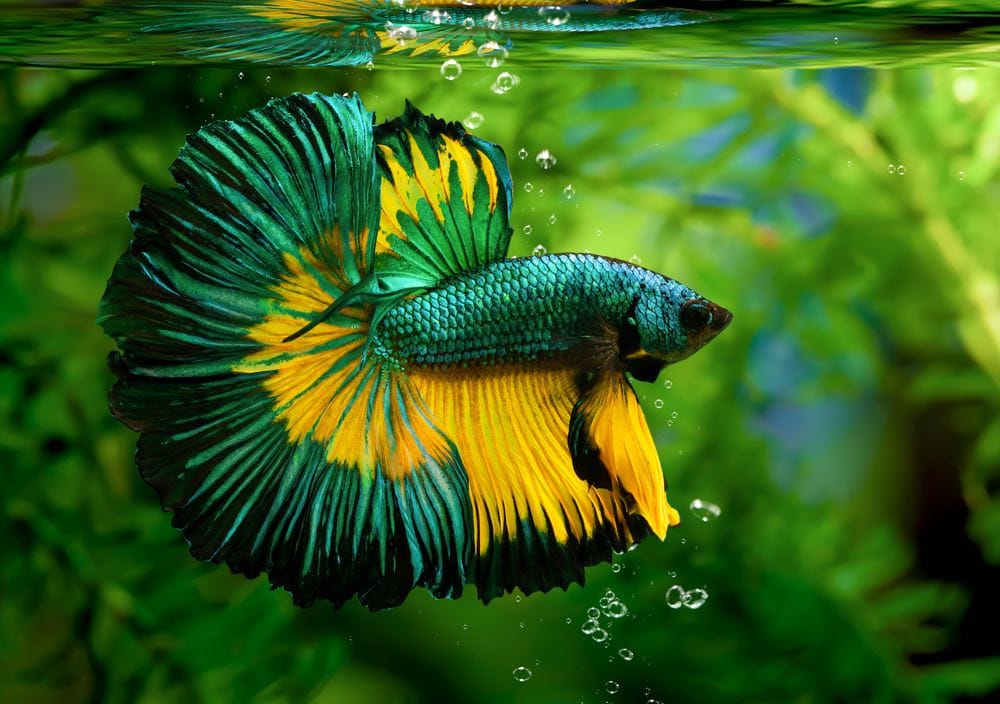
How Do I Transfer My Fish From One Tank to Another?
If you keep multiple tanks in your home and wish to transfer your betta from one tank to another, then you can scoop your betta in a net and transfer them over into the new tank if the following criteria are met:
- You use the same water source in both tanks
- The water in both tanks is the same in other measures, too (such as temperature and pH)
- Both tanks had a water change performed within the last week
- The new aquarium is suitable for your betta (no aggressive tank mates, appropriate size, no strong currents, and cycled)
- Both tanks are in the same room, or the rooms that house the tanks have the same ambient temperature.
If these criteria are not met, you should place your betta in a bag with water from their current tank and then acclimate them to the new tank.
My Betta Is in a Cup, Not a Bag. What Should I Do?
If you purchased your betta in a cup, it’s best to transfer them into a bag (with the water in the cup) before acclimating them to your aquarium. Cups are dangerous for transporting fish, as they can easily topple over, and their lid is rarely leak-proof. Your betta’s ability to breathe in atmospheric oxygen via their labyrinth organ means that they can easily survive in a tied bag that isn’t supplemented with oxygen for a few hours while you transport and acclimate them.
You should do the same if your betta is in a transport tank, as it is difficult to float a tank within another tank.
Conclusion
When bringing home a betta, it is important to acclimate them to their environment carefully. This involves making sure you slowly allow them to get used to the new water they will be housed in. Though a long process, it should be considered mandatory. With successful acclimation, your new fish will surely provide long periods of companionship and joy.
Featured Image Credit: panpilai paipa,Shutterstock




